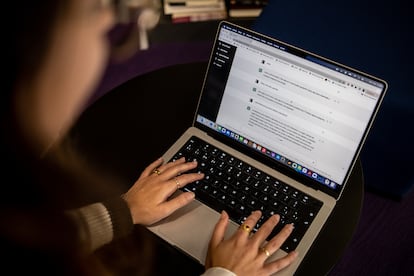‘It works very well, but it’s not magic’: Introducing ChatGPT, the groundbreaking AI chatbot
The latest evolution in text generation systems has surprised hundreds of thousands of users with coherent conversations and a humanlike finesse

Just five days after its November 30 launch, the ChatGPT artificial intelligence model, a system that answers any question you pose with unprecedented coherence, already had more than a million users. OpenAI, its creator and one of the leading companies in artificial intelligence, made it available to any user, prompting social media feeds to fill with screenshots of solved programming requests, answers to deep questions and more – including some obvious mistakes. “It works very well, but it’s not magic,” says Álvaro Barbero Jiménez, director of artificial intelligence at the Knowledge Engineering Institute (IIC), in Spain.
“It’s a tremendous innovation, I was also shocked,” explains Barbero Jiménez. “I asked it to solve some programming exercises that I give to those who join my team, and it did a perfect job. But then I asked it about a programming project with an awful mistake and it gave me a made-up solution. It told me to use a tool that didn’t exist.”
The system is extremely easy to use. You just have to go to chat.openai.com, open an account with an email and password and start chatting with the robot.
I’m sorry, I simply cannot be cynical about a technology that can accomplish this. pic.twitter.com/yjlY72eZ0m
— Thomas H. Ptacek (@tqbf) December 2, 2022
It comes in an incredible year for artificial intelligence models. In the summer, the AI program Geniverse created illustrations from text requests; before that, the GPT-3 model generation text based on an initial sentence. And now the latest version of the GPT software has surprised again with its humanlike responses, sparking a debate between two groups: the enthusiasts who hail the achievement as the prelude to a general artificial intelligence, capable of reasoning and self-awareness, and those who are more cautious about the results. Nonetheless, everyone agrees that this is a technological feat.
Carlos Fenollosa, CEO of the AI company Optimus Price, is one of the experts who are optimistic about its potential. “It is capable of meta-reasoning. That is, it understands why it is giving you one answer and not another. It’s the first time I’ve seen this in an AI,” he says.
POV: You're a Senior Data Engineer at Twitter. Elon asks what you've done this week. You've done nothing.
— Riley Goodside (@goodside) December 3, 2022
Frantically, you open ChatGPT. pic.twitter.com/L2RioReMBC
The model itself is somewhat more prudent about its abilities. When asked “who are you,” ChatGPT responded: “As a language model trained by OpenAI, I can process language and speak in a similar way to a human being. This means that I can understand questions and provide coherent answers using human language. Unlike a human, however, I do not have self-awareness or the ability to think and reason autonomously. I am simply a computer program designed to mimic human language.” Sounds like what a machine would say to calm down the nervous humans.
Julio Gonzalo, vice-rector for research at the National University of Distance Education in Madrid, Spain, was also surprised when he started using the system; but he is more cautious and admits that it still has a long way to go. “It appears to know about any subject, and it can convince you in a superficial conversation, but if you dig deeper you’ll realize that it is speaking from hearsay or, to put it more bluntly, it doesn’t know what it’s talking about. It has intuitively learned to hold conversations on almost any subject, and appears to have real knowledge and to be able to combine it with rational thought, but it’s only an appearance: it has not been taught to reason, nor does it have explicit knowledge,” he says.
What lies ahead
The enthusiasm is hard to contain when one sees the results of a user asking it, for example, to tell him how to remove a peanut butter sandwich from a VCR in a biblical tone, or the debate it held (in Spanish) with Manuel Maroto, a professor at the Complutense University of Madrid, about criminal law. Maroto was surprised by the results: “Its level, taking into account the length of the responses, is good,” he said. “The fact that it says relatively incorrect things is a different matter,” he is quick to add. But the fact alone that a robot created at a Silicon Valley startup is able to hold a conversation about criminal law in Spanish is overwhelming.
The list of jobs in which artificial intelligence can help (or even end up replacing) has grown. The threats posed by machines are no longer limited to industrial plants; this chatbot can answer questions that inexperienced programmers, teachers or writers may answer less clearly. Some tasks, such as writing essays, may change forever with this technology.
#ChatGPT is amazing!🧐🥰 pic.twitter.com/7rGgvvYOQO
— LUNC_NYMPH ®🌕 (@lunc_nymph) December 7, 2022
“With the tests we have carried out, many of us are clear that it will be able to do the job of a programmer very well,” says Victoriano Izquierdo, co-founder of Graphext, a data analysis company. “It will make it possible to get at operating system level and perform really complex tasks. Perhaps now, paradoxically, it’s the professions that require more physical skill, such as being a dentist or a hairdresser, the ones that seem more difficult to replace, until hardware advances further and we are not afraid of a mechanical Edward Scissorhands,” he adds, in reference to the character from Tim Burton’s hit movie.
Fenollosa goes further with the list of jobs at risk. “It will do away with all copywriters, including journalists (if they don’t do reporting). For example, things like press releases or summaries of current affairs. It will do away with Q&A, such as Stack Overflow [a question and answer website about coding where they had to block the use of the chat due to excessive errors] or Quora [generic questions], including the work of solving doubts from many professors. Also, simple programming, design and illustration. You can say to ChatGPT: ‘design a website for a construction materials manufacturing company and include several stock photos of people visiting a construction site’ and it will give you a starting point that would have taken a human a couple of days to prototype,” he explains.
The robot will even be able to make good jokes, says Fenollosa. “I don’t mean that it is able to write funny stories by combining pieces from other stories. ChatGPT understands irony and the elements of humor, it is capable of making up new jokes,” he says.
“Of course it will impact professions. But on the scale between ‘rest assured’ and ‘it’s the end of humanity,’ we are somewhere in the middle,” adds Barbero Jiménez.
There is a small glimmer of hope: these tools can provide “automatic production;” but adding value will be a strictly human, artisanal task.
Sign up for our weekly newsletter to get more English-language news coverage from EL PAÍS USA Edition
Tu suscripción se está usando en otro dispositivo
¿Quieres añadir otro usuario a tu suscripción?
Si continúas leyendo en este dispositivo, no se podrá leer en el otro.
FlechaTu suscripción se está usando en otro dispositivo y solo puedes acceder a EL PAÍS desde un dispositivo a la vez.
Si quieres compartir tu cuenta, cambia tu suscripción a la modalidad Premium, así podrás añadir otro usuario. Cada uno accederá con su propia cuenta de email, lo que os permitirá personalizar vuestra experiencia en EL PAÍS.
¿Tienes una suscripción de empresa? Accede aquí para contratar más cuentas.
En el caso de no saber quién está usando tu cuenta, te recomendamos cambiar tu contraseña aquí.
Si decides continuar compartiendo tu cuenta, este mensaje se mostrará en tu dispositivo y en el de la otra persona que está usando tu cuenta de forma indefinida, afectando a tu experiencia de lectura. Puedes consultar aquí los términos y condiciones de la suscripción digital.
More information
Archived In
Últimas noticias
‘Fallout’ or how the world’s largest company turned an anti-capitalist apocalyptic Western into a phenomenon
From inflation to defending migrants: Eileen Higgins and Zohran Mamdani inaugurate the new Democratic resistance against Trump
EU’s prestige at stake with proposal to fund Ukrainian war effort with Russian assets
Mustafa Suleyman: ‘Controlling AI is the challenge of our time’
Most viewed
- ‘El Limones’ and the growing union disguise of Mexican organized crime
- Christian Louboutin: ‘Young people don’t want to be like their parents. And if their parents wear sneakers, they’re going to look for something else’
- ‘We are dying’: Cuba sinks into a health crisis amid medicine shortages and misdiagnosis
- The low-cost creative revolution: How technology is making art accessible to everyone
- A mountaineer, accused of manslaughter for the death of his partner during a climb: He silenced his phone and refused a helicopter rescue











































